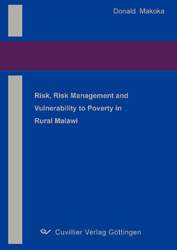| Fachbereiche | |
|---|---|
| Buchreihen (96) |
1379
|
| Nachhaltigkeit |
3
|
| Gesundheitswesen |
1
|
| Geisteswissenschaften |
2367
|
| Medienwissenschaften | 16 |
| Theologie | 57 |
| Philosophie | 102 |
| Rechtswissenschaft | 422 |
| Wirtschaftswissenschaften | 851 |
| Sozialwissenschaften | 416 |
| Sportwissenschaften | 48 |
| Psychologie | 233 |
| Pädagogik | 190 |
| Geschichtswissenschaften | 183 |
| Kunstwissenschaften | 111 |
| Kulturwissenschaften | 166 |
| Literaturwissenschaften | 117 |
| Sprachwissenschaften | 88 |
| Naturwissenschaften |
5407
|
| Ingenieurwissenschaften |
1793
|
| Allgemein |
98
|
|
Leitlinien Unfallchirurgie
5. Auflage bestellen |
|
Erweiterte Suche
Risk, Risk Management and Vulnerability to Poverty in Rural Malawi
Donald Makoka (Autor)Vorschau
Inhaltsverzeichnis, Datei (60 KB)
Leseprobe, Datei (93 KB)
Vulnerability to poverty in Malawi is highly associated with risk. Rural households face
multiple shocks, most of which threaten their livelihoods and impact negatively on their
welfare. This study investigates three inherently interconnected issues: vulnerability to
poverty; risk management strategies; and consumption smoothing. The central research
issue is on understanding the role of risk in household vulnerability and poverty. Using a
two-period panel dataset of 259 households in rural Malawi, the study addresses three
objectives: First, to identify the determinants of vulnerability in rural Malawi. Second, to
analyze households’ coping mechanisms for different shocks and identify the
determinants of these mechanisms. Third, to test for the existence of household
consumption smoothing as an insurance mechanism against idiosyncratic shocks.
The panel dataset used in the study was derived from the 2004 second Malawi Integrated
Household Survey (IHS2) from which 259 households were sampled and followed up in
2006 with a similar questionnaire. Vulnerability was modelled as expected poverty using
Christiaensen and Subbarao (2004) methodology to investigate the extent to which rural
households in Malawi are vulnerable to poverty. The results show that in 2004 the
sampled households had an average chance of 44 percent of falling into poverty in 2006
and around 21 percent of the non-poor in 2004 were vulnerable to poverty in 2006.
Further, female-headed households appear to be more vulnerable than their male
counterparts. Education, land holdings and running a non-farm income generating
activity in the household reduce household vulnerability. Community infrastructures such
as health clinics and access to markets have vulnerability-reducing effects. These
correlates of vulnerability are extremely similar to the correlates of poverty among the
sampled households. Both covariate and idiosyncratic shocks are felt more by the
vulnerable households. The results further show that vulnerability among the studied
households is exacerbated by low average consumption levels more than consumption
volatility.
The determinants of risk management strategies were analyzed using a multinomial
logistic regression model. The results have shown that drought, rising food prices and
illness are among the major shocks that the sampled households face, with crop
diversification being used as an ex-ante risk management strategy. Ex-post coping
strategies take the form of safety net programs, use of household assets and getting
support from social networks, among others. The major determinants of the choice of the
ex-post coping strategy among the studied households include the size of the household,
the number of economically active individuals in the household, per capita landholdings,
ownership of livestock, access to markets and the type of shocks that households face.
Consumption smoothing was analyzed using a household asset index due to
unavailability of household income data. A test for consumption smoothing was then run
by considering the impact of changes in the household asset index between 2004 and
2006 on changes in consumption. The results, which are robust to measurement error in
consumption expenditure, show that the studied households try to protect their
consumption from shocks, with food consumption being protected more than non-food
consumption. Further, poor households tend to protect their food consumption more than
the non-poor households. However, the study found no evidence of perfect consumption
smoothing.
The major policy implications are that poverty reduction programmes would be more
effective in rural Malawi if they do not only incorporate the currently poor but also the
vulnerable. Since the study has shown that the main source of vulnerability appears to be
low mean consumption levels among the studied households, social protection
programmes that take the form of productivity-enhancing safety nets, targeting not only
the poor but also the vulnerable would be effective to help them cope with shocks and
increase household mean consumption levels. Programmes that help rural households to
accumulate assets are also needed to help them cope with shocks. Further, promotion of
small and medium scale irrigation schemes as well as the use of weather insurance, as a
means of reducing the costs associated with crop failure, could be effective in dealing
with the major covariate shock, drought.
| ISBN-13 (Printausgabe) | 386727746X |
| ISBN-13 (Printausgabe) | 9783867277464 |
| ISBN-13 (E-Book) | 9783736927469 |
| Sprache | Englisch |
| Seitenanzahl | 226 |
| Auflage | 1 Aufl. |
| Band | 0 |
| Erscheinungsort | Göttingen |
| Promotionsort | Universität Bonn |
| Erscheinungsdatum | 17.09.2008 |
| Allgemeine Einordnung | Dissertation |
| Fachbereiche |
Wirtschaftswissenschaften
|
| Schlagwörter | Armut, Verwundbarkeit, Schocks, Risikomanagement, ländlichesMalawi |








